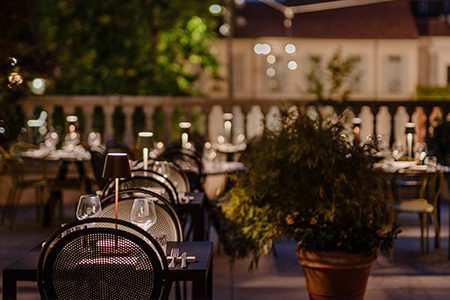Reopen the Blue Note and go back to dinner with music. And so to taste the "holy trinity" of Cajun cuisine, based on green peppers, onions and celery, you no longer need to fly to Louisiana. Just book in Milan
In New Orleans they call it the "holy trinity" of cooking: green peppers, onions and celery. Almost impossible not to find them in the typical Cajun dishes of Louisiana, a land of jazz and a history of great contamination. Here music and recipes have the same sound, the same story to tell, the same warmth: spicy and intoxicating. But if the United States is far away, the Blue Note of Milan it is in the heart of the Isola area and has been bringing the best of jazz and blues music to the city for years now. Now Cajun cuisine too.
Jazz and Cajun cuisine, the soul of New Orleans
Jazz was born in New Orleans and from slave labor songs it becomes itinerant music played in street brass bands, made to dance, to have fun, to escape, and only at the end does it end up in clubs and then recorded on records. It is the same story of Creole cuisine, born from the meeting of different cultures, origins and traditions that took place in these lands. A poor, robust cuisine, made with local ingredients, made inviting by spices and aromas from afar. Cajuns were the French colonists who emigrated from Canada to lower Louisiana at the end of the eighteenth century, bringing with them very particular culture, ingredients and recipes that are still recognizable today after three centuries and part of the tradition of those lands. The city takes its name from Orléans along the Loire, but is on the Mississippi River and is known for its French Quarter and Old European-inspired architecture. The cuisine also reflects centuries-old history: Cajun cuisine is a combination of French cuisine and tradition of the Southern United States in which smoked meat, spicy pork sausage and rice known as boudin or crayfish are cooked in a single pot: the jambalaya. But French culture was evidently not the only one to cross this area, and Creole culture is strong, the product of European and African, Caribbean or Hispanic descendants that make up the majority of the population here. The essence of Creole is found in rich sauces, local herbs, red tomatoes, fish and seafood.
At the Blue Note you can dine to the rhythm of music
The Blue Note celebrates its 17 years of activity in which it has brought jazz, blues, gospel and African-American inspired music to the heart of Milan, adding a new note: to be the first Cajun restaurant in Milan. Along with international cuisine such as the inevitable burgers, it also offers dishes born right in the streets of New Orleans, Louisiana, in the deep south of the United States, one of the most incredible cities in the world: with its Caribbean tones and its typical mixture of cultures that have left their mark in almost three hundred years of history. Chef Federico Tronci of Blue Note Milano, after careful research among the historical testimonies of the time, has outlined an ad hoc menu proposing reworked dishes that will vary seasonally. "Cajun cuisine is the result of the ingenuity of those peoples who have learned to survive in unknown and inhospitable lands, made of swamps and marshes and have been able to wisely mix different gastronomic traditions – French, Spanish and Caribbean – with poor local products – rice, crustaceans, molluscs , says Federico Tronci. "With this new menu we want to go back to the historical roots of jazz and focus on a simple cuisine, with few ingredients, but all easily recognizable". We start with i fried: tender chicken marinated in spices or prawns battered in beer and served with homemade creole or smoked sauce. Typical of Criolla cuisine, the Shrimp gumbo, a slightly spicy soup served with white rice and fried bread or the brisket BBQ with white rice and red beans in sauce. For those who want to taste just one sandwich, you can order the brisket and mustard one, but the important thing is not to miss the dessert: Banana foster, with caramelized banana and vanilla ice cream (which comes here directly from one of the best ice cream parlors in Italy, Artico, a few steps from the restaurant).
The evening of the reopening
Celebrate New Orleans will be held on Tuesday 22 September to celebrate one of the most incredible cities in the world, the cradle of jazz. The evening will be dedicated to Creole culture at 360 degrees: on stage the Domenico Mamone Quintet will make the public savor the dawn of jazz, from the sessions with Louis Armstrong, to the blues and dixieland echoes, retracing the stages of the musical career of the jazz legend Sidney Bechet ; while those who will also enjoy dinner, will be able to savor traditional Cajun dishes.

